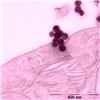Home > Press > A golden thread through the labyrinth of nanomaterials
 |
| Iron oxide nanoparticles on the surface of a cell |
Abstract:
The LICARA guidelines are geared towards small and medium-sized enterprises (SMEs) from all branches of industry, and help weigh up the pros and cons of nanomaterials and make decisions on their use. The guidelines also do their bit towards efficient communication in the value added chain.
A golden thread through the labyrinth of nanomaterials
Switzerland | Posted on December 12th, 2014The use of nanomaterials can yield new or significantly improved product features. Industry would like to use the specific properties of nanomaterials for competitive products, but also avoid risks to humans and the environment. Many questions on the benefits and risks of nanomaterials are still open and the European legislation is challenging. Empa issued a set of guidelines entitled LICARA as part of the EU project "LICARA" in conjunction with the Dutch research institution TNO, Nano-Cluster Bodensee and six other partners from European industry. The guidelines address the following questions:
Where and how can nanomaterials be useful?
What are nanospecific hazards for humans and the environment?
What legal framework is there?
How sustainable are nanoproducts?
In addition to the guidelines, an Excel tool, the LICARA nanoSCAN, is available to illustrate benefit-risk trade-offs with nanomaterials semi-quantitatively. The easy-to-use LICARA guidelines are available for download at www.empa.ch/licara, where the link to the LICARA nanoSCAN is also provided.
An initial decision-making basis in seven simple steps
The LICARA guidelines begin by explaining the terms nanoparticles, nanomaterial and nanoproducts. Not everything that carries the "nano" label contains nanoparticles. The legal situation is also explained. If nanoparticles are used in products in the cosmetics, food and pesticide sectors, the strict regulations on registration and declaration must be observed. There are also registration rules for products from other industries. Steps 3 and 4 are devoted to the potential benefits of nanomaterials. The fifth step reveals how the safety and also the quality of the products can be influenced positively throughout their lifecycle in the product design. Step 6 stretches from the state of research to potential risks. Via these steps, the reader is systematically ushered towards an initial decision-making basis as to whether and with which nanomaterials innovative products can be developed successfully (step 7). This decision-making basis can also be used to communicate efficiently with the customers, suppliers and authorities about the product. The LICARA NanoSCAN subsequently provides more detail.
Guidelines for nanotextiles
Back in 2011, Empa published the Nano Textiles guidelines on the safe access to and handling of nanotechnology in the textiles and clothing industry in conjunction with the textiles association Swiss Textiles. This 21-page brochure, which addresses special issues from the production of textiles, can be downloaded at www.empa.ch/nanosafetextiles.
####
For more information, please click here
Contacts:
Rainer Klose
Copyright © AlphaGalileo
If you have a comment, please Contact us.Issuers of news releases, not 7th Wave, Inc. or Nanotechnology Now, are solely responsible for the accuracy of the content.
| Related News Press |
News and information
![]() Researchers develop molecular qubits that communicate at telecom frequencies October 3rd, 2025
Researchers develop molecular qubits that communicate at telecom frequencies October 3rd, 2025
![]() Next-generation quantum communication October 3rd, 2025
Next-generation quantum communication October 3rd, 2025
![]() "Nanoreactor" cage uses visible light for catalytic and ultra-selective cross-cycloadditions October 3rd, 2025
"Nanoreactor" cage uses visible light for catalytic and ultra-selective cross-cycloadditions October 3rd, 2025
Standards/Certifications
![]() NIOSH Releases New Nanotechnology Workplace Design Recommendations March 13th, 2018
NIOSH Releases New Nanotechnology Workplace Design Recommendations March 13th, 2018
![]() Oxford Instruments NanoScience achieves the latest ISO9001:2015 certification March 2nd, 2017
Oxford Instruments NanoScience achieves the latest ISO9001:2015 certification March 2nd, 2017
Materials/Metamaterials/Magnetoresistance
![]() First real-time observation of two-dimensional melting process: Researchers at Mainz University unveil new insights into magnetic vortex structures August 8th, 2025
First real-time observation of two-dimensional melting process: Researchers at Mainz University unveil new insights into magnetic vortex structures August 8th, 2025
![]() Researchers unveil a groundbreaking clay-based solution to capture carbon dioxide and combat climate change June 6th, 2025
Researchers unveil a groundbreaking clay-based solution to capture carbon dioxide and combat climate change June 6th, 2025
![]() A 1960s idea inspires NBI researchers to study hitherto inaccessible quantum states June 6th, 2025
A 1960s idea inspires NBI researchers to study hitherto inaccessible quantum states June 6th, 2025
![]() Institute for Nanoscience hosts annual proposal planning meeting May 16th, 2025
Institute for Nanoscience hosts annual proposal planning meeting May 16th, 2025
Announcements
![]() Rice membrane extracts lithium from brines with greater speed, less waste October 3rd, 2025
Rice membrane extracts lithium from brines with greater speed, less waste October 3rd, 2025
![]() Researchers develop molecular qubits that communicate at telecom frequencies October 3rd, 2025
Researchers develop molecular qubits that communicate at telecom frequencies October 3rd, 2025
![]() Next-generation quantum communication October 3rd, 2025
Next-generation quantum communication October 3rd, 2025
![]() "Nanoreactor" cage uses visible light for catalytic and ultra-selective cross-cycloadditions October 3rd, 2025
"Nanoreactor" cage uses visible light for catalytic and ultra-selective cross-cycloadditions October 3rd, 2025
|
|
||
|
|
||
| The latest news from around the world, FREE | ||
|
|
||
|
|
||
| Premium Products | ||
|
|
||
|
Only the news you want to read!
Learn More |
||
|
|
||
|
Full-service, expert consulting
Learn More |
||
|
|
||








